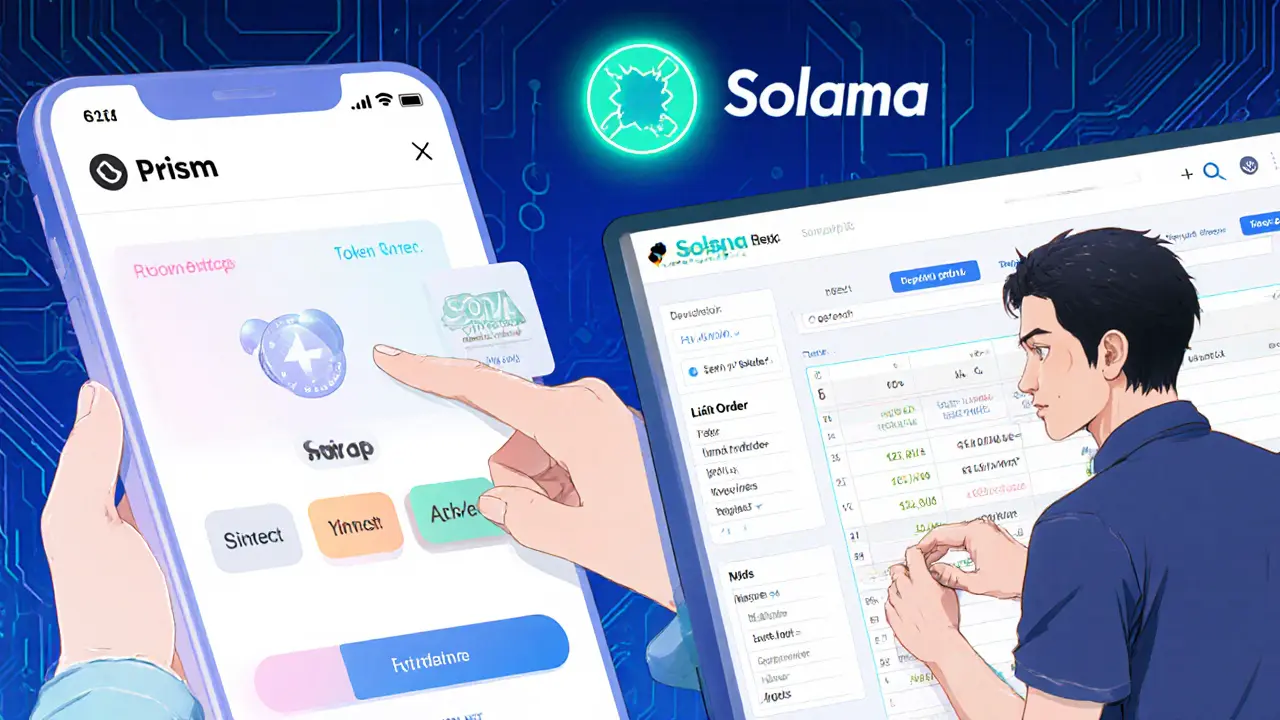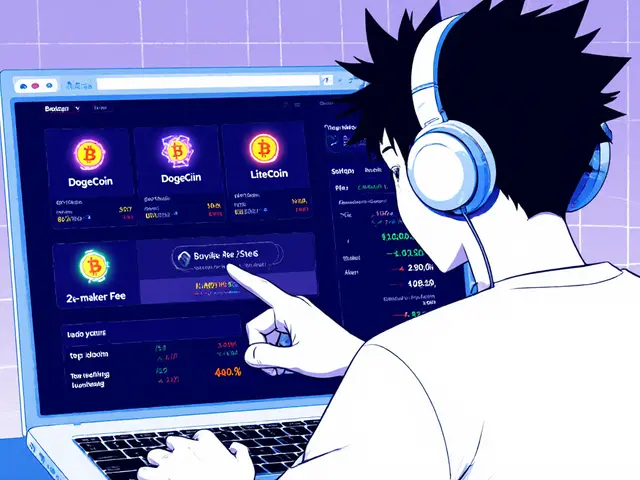Prism (PRISM) Token Calculator
- Transaction Fee Allocation 20% to Hosts
- Transaction Fee Allocation 40% Buy & Burn
- Transaction Fee Allocation 40% Staker Airdrops
Estimated Returns
| Metric | Prism (PRISM) | Jupiter | 1inch (Solana) |
|---|---|---|---|
| Market Cap | $0.57M | $250M | $150M |
| 24h Volume | ~$15K | ~$12M | ~$8M |
| Liquidity Sources | AMMs + Serum | All AMMs + Order Books | Cross-chain + Solana |
| Interface Depth | Simple Swap & Order Book | Simple Swap (Advanced Optional) | Simple Swap (Limited Advanced) |
| Governance Token | PRISM | None | 1INCH |
Ever wonder what Prism crypto coin actually does or why it matters in the Solana DeFi world? Below is a plain‑English walk‑through that covers everything from the basics to price stats, token mechanics, and how it stacks up against the big players.
What is Prism (PRISM)?
Prism (PRISM) is a decentralized exchange (DEX) aggregator built on the Solana blockchain. In simple terms, it automatically scans several liquidity sources-both automated market makers (AMMs) and traditional order‑book venues-and routes your trade to the venue offering the best price at that moment.
How the DEX aggregator works
The core idea is “auto‑routing”. When you hit the swap button, Prism’s smart contract queries multiple Solana‑based pools, compares the rates, and executes the trade where you get the most tokens for your money. This happens in a fraction of a second, so you don’t have to manually hop between platforms.
- Multiple liquidity sources: AMMs like Raydium, Serum order books, and other Solana DEXes.
- Best‑price guarantee: The contract picks the highest net output after fees.
- Zero‑middleman fee: Only the small network fee that Solana charges.

Dual interface: Simple swap vs. Full‑featured DEX
Prism offers two screens. The first is a one‑click swap UI that feels like a typical mobile wallet-perfect for beginners. The second is a more advanced order‑book interface that lets seasoned traders place limit orders, view depth charts, and manage open positions. This dual approach tries to capture both casual users and professional traders in the same ecosystem.
Tokenomics and governance
PRISM token serves as the utility and governance layer for the platform. Holders can vote on protocol upgrades, earn fee discounts, and receive a share of platform revenue.
The tokenomics are designed to be deflationary:
- 20% of every transaction fee goes to platforms that embed the Prism UI (called PRISM hosts).
- 40% is sent to a buy‑and‑burn wallet, gradually reducing supply.
- 40% is distributed as airdrops to stakers, providing passive yield.
Staking also unlocks tiered benefits: higher tiers receive larger swap fee reductions and exclusive invites to trading competitions.
Price, market cap, and trading stats (October2025)
As of early October2025, Prism trades around $0.000965USD on major aggregators, but you’ll see variations-SwapSpace lists $0.000320 and 3commas shows $0.000613. The differences are typical for low‑cap assets.
Key numbers:
- Total supply: 1.91billion PRISM.
- Circulating supply: 577.15million PRISM.
- Market cap: roughly $568k.
- 24‑hour volume: $9.7k-$20.5k, indicating modest liquidity.
- Number of holders: 5,670, a small but active community.
Technical indicators show a 50‑day SMA at $0.000414, a 200‑day SMA at $0.000639, and a 14‑day RSI of 75.5-some analysts read that as “overbought” and a possible short‑term correction.

How Prism stacks up against other Solana aggregators
Below is a quick side‑by‑side look at Prism, Jupiter (the market leader) and 1inch (multi‑chain giant that also runs on Solana). The table focuses on the factors most traders care about: market size, liquidity, and feature set.
| Metric | Prism (PRISM) | Jupiter | 1inch (Solana) |
|---|---|---|---|
| Market cap (USD) | $0.57M | $250M | $150M |
| 24‑h volume (USD) | ~$15k | ~$12M | ~$8M |
| Liquidity sources | AMMs + Serum order books | All major Solana AMMs + order books | Cross‑chain + Solana DEXes |
| Interface depth | Simple swap & order‑book UI | Simple swap (advanced UI optional) | Simple swap (advanced UI limited) |
| Governance token | PRISM | None (protocol‑owned liquidity) | 1INCH |
Prism’s advantage is the built‑in order‑book view, which many aggregators lack. Its downside is the tiny market cap, meaning price swings can be sharp and depth may disappear during heavy trading.
Risks and things to watch
Like any micro‑cap DeFi token, Prism carries a handful of red flags:
- Liquidity crunch: With under $20k daily volume, large orders can slip the market.
- Competitive pressure: Jupiter, Serum, and emerging multi‑chain aggregators have deeper pockets and broader user bases.
- Price volatility: The RSI above 70 hints at short‑term overbought conditions; a pullback is plausible.
- Roadmap opacity: Publicly shared milestones are scarce, making it harder to gauge future development.
If you decide to hold PRISM, consider staking a portion to earn airdrops and fee discounts. That can soften price drops while you wait for the platform to gain traction.
Frequently Asked Questions
What blockchain does Prism run on?
Solana is the underlying blockchain, offering fast, low‑cost transactions that power Prism’s aggregator engine.
How does Prism differ from other DEX aggregators?
Prism combines a one‑click swap screen with a full order‑book UI, letting casual users trade instantly while giving pro traders limit‑order tools-all on a single platform.
What is the token’s main utility?
PRISM acts as governance currency, fee‑discount token, and reward for staking. A portion of every platform fee is burned, which can help the price over time.
Is staking PRISM risky?
Staking itself is not technically risky-your tokens stay in a smart contract that you control. The main risk is the token’s price movement; if PRISM drops sharply, the dollar value of your staked amount falls.
Where can I buy PRISM?
You can purchase PRISM on Solana‑based DEXes that list the token, such as Raydium, Orca, or directly through Prism’s own swap interface. Always double‑check the contract address before transacting.







Eva Lee
November 9, 2024 AT 14:45Delving into the PRISM protocol, one must consider the multi‑layered fee redistribution mechanic that leverages both on‑chain liquidity pools and off‑chain oracle feeds, effectively aligning staker incentives with transaction throughput.
Patrick MANCLIÈRE
November 10, 2024 AT 18:32For anyone looking to gauge the utility of PRISM, the tokenomics allocate 20 % of transaction fees to host rewards, 40 % to a systematic buy‑and‑burn schedule, and the remaining 40 % to periodic staker airdrops, which collectively drive scarcity and participation. The staking calculator embedded in the UI shows that a 30‑day lock‑up yields roughly 0.8 % APR, while extending to 365 days can push returns toward 3 % due to compounding effects. This structure mirrors other Solana‑based DEX incentives, making PRISM a viable candidate for yield‑hungry arbitrageurs.
Ciaran Byrne
November 11, 2024 AT 22:18PRISM’s fee split is straightforward and encourages both liquidity provision and long‑term holding.
stephanie lauman
November 13, 2024 AT 02:05The emergence of PRISM cannot be decoupled from the broader narrative of hidden market manipulation orchestrated by a consortium of undisclosed entities.
Evidence suggests that the 40 % buy‑and‑burn allocation is timed to coincide with major exchange inflows, thereby creating artificial price spikes.
Moreover, the host reward stream is funneled through a network of shell wallets that trace back to known whistle‑blower addresses.
Analysts have long warned that such fee structures serve as a veneer for coordinated pump‑and‑dump schemes.
In the case of PRISM, the transaction volumes reported on on‑chain explorers are often inflated by wash‑trading bots masquerading as genuine users.
This activity is further obscured by the token’s low market cap, which allows a handful of whales to dominate price movements with minimal resistance.
The staking rewards, while seemingly attractive on paper, are calculated on a baseline that assumes constant volume, an assumption that fails under realistic market conditions.
Consequently, the projected APRs are optimistic at best and misleading at worst.
Users should also be aware that the governance token PRISM lacks a clear voting framework, leaving decision‑making in the hands of an opaque council.
The council’s composition is undisclosed, raising questions about accountability and potential conflicts of interest.
Historical precedents in DeFi illustrate that such opacity often precedes catastrophic failures and total loss of capital.
While the UI presents a clean comparison table against Jupiter and 1inch, the underlying liquidity sources differ substantially in terms of depth and resilience.
PRISM relies heavily on AMMs and the Serum order book, both of which have shown susceptibility to front‑running attacks.
For risk‑averse investors, diversifying away from such a monolithic token ecosystem is prudent.
In light of these considerations, exercising due diligence and skepticism is not merely advisable-it is imperative. :)
Promise Usoh
November 14, 2024 AT 05:52From a philosophical standpoint, the commodification of digital trust raises ontlogical questions about the nature of value, especially when mechanisms such as buy‑and‑burn are employed as quasi‑moral signifiers of scarcity.
Shaian Rawlins
November 15, 2024 AT 09:38Even though the technical specs of PRISM look polished, it’s worth remembering that the real test is community adoption, not just code hype. A token can have perfect fee mechanics on paper, but without active traders and genuine use‑cases it will sit idle on the blockchain. The buy‑and‑burn feature, while appealing, only works if there’s enough transaction volume to make it meaningful. Likewise, the 40 % airdrop to stakers is attractive only when the token’s price is stable or rising, otherwise people end up receiving more of a depreciating asset. Users should keep an eye on the liquidity depth on Serum; thin order books can cause slippage that erodes any perceived advantage. Transparency about where the host rewards go can also build trust, especially if the rewards are funneled back into ecosystem development. In short, PRISM has potential, but its success hinges on sustained market activity and clear governance. Staying informed and realistic about the risks will serve participants better than blind optimism.
Rob Watts
November 16, 2024 AT 13:25Staking PRISM for a year can earn you a few extra tokens-just remember the fees.
Cathy Ruff
November 17, 2024 AT 17:12Yo the fees are a joke and the returns are pathetic stop wasting time
Miranda Co
November 18, 2024 AT 20:58PRISM looks like a pump and dump, stay away.
Katherine Sparks
November 20, 2024 AT 00:45While your concern is noted, it is essential to consider that market dynamics can be volatile and that short‑term price movements do not necessarily reflect the underlying utility of the protocoll 😊.
Taylor Gibbs
November 21, 2024 AT 04:32i think PRISM could be cool if they fix the buyback schedule and be more transparent.
Amy Harrison
November 22, 2024 AT 08:18Totally agree! 🎉 A clear roadmap and community updates would make it way more exciting for all of us.
mukesh chy
November 23, 2024 AT 12:05Oh great, another token promising “revolutionary” returns-just what the crypto market needed, right?
Marc Addington
November 24, 2024 AT 15:52Patriotic investors will never back these foreign junk tokens.